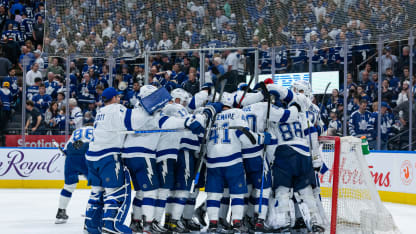For the first six games of Lightning-Leafs, momentum was the big storyline. The team that grabbed it dominated play. In Games One through Four, the side with momentum built a lead that it wouldn't relinquish. Games Five and Six, on the other hand, featured momentum swings within the contests. Those were the first two games in which there were lead changes. Still, the common denominator was that momentum fueled the dangerous offensive attacks from both clubs. There were a lot of scoring chances and a lot of goals. All that changed, of course, in Game Seven. It was the first tight-checking, defensive-oriented game in the series. Also the lowest-scoring. Momentum within the game was present, but strong defensive play from both sides helped offset it.
Here's a look back at how the first-ever series between Tampa Bay and Toronto unfolded, game-by-game.
Mishkin's Musings: Recapping a back-and-forth series win over Toronto
Radio broadcaster Dave Mishkin on Tampa Bay's high-scoring, momentum-fueled First Round victory

© Julian Avram/Icon Sportswire/Getty Images
The Lightning began Game One with a golden opportunity. Seven minutes of power play time over the first 12 minutes. But not only did the Lightning not score on either the two-minute or major power play, they surrendered momentum. The Maple Leafs generated several shorthanded chances - especially during the major kill - and never looked back. A late first period goal from Jake Muzzin allowed the Leafs to take a lead into the first intermission. In the second period, a five-on-three Auston Matthews power play goal came minutes before David Kampf's shorthanded tally. From that point onward, the Leafs were skiing downhill as the Lightning provided little resistance. Mitch Marner finished an open rush chance from the slot before the period ended and Matthews wrapped up the scoring in the third.
In Game Two, the roles reversed. The Leafs were the ones with a chance to go up early, but couldn't convert on two first period power plays. Instead, the Lightning got the game's first goal - Victor Hedman swept in a power play shot from the top of the crease seconds before the frame ended. Early in the second, Andrei Vasilevskiy made a highlight-reel save on Timothy Liljegren's shot from the slot. Shortly thereafter, Hedman sprung Corey Perry on a breakaway and Perry made it 2-0. Although the Leafs got one back following a Tampa Bay d-zone turnover, Nikita Kucherov answered almost immediately with another Lightning power play goal. The Leafs didn't muster any pushback until the middle of the third, at which point the score was 5-1. A couple of goals pulled Toronto to within two, but the Leafs would get no closer.
Toronto failed to score either of its first period power play chances in Game Two, but the Leafs did convert on the PP at the beginning of Game Three. A Lightning delay of game penalty opened the door for Toronto and the Leafs charged through it. A dynamic Toronto power play ended with Morgan Rielly's opening tally, which came with just two seconds left on the man advantage. Later in the first, moments after the Leafs killed off a Lightning power play, they countered on a three-on-one. Colin Blackwell, who had come out of the penalty box to join the rush, swept a shot into an open side of the net to extend the Toronto lead.
The Leafs decisively carried play through the middle of the second period. Kampf's goal off the rush made it 3-0. The Lightning found their rhythm after Ross Colton's power play goal at 11:03 of the second. They cut the deficit to one when Ondrej Palat scored at 5:43 of the third. But Jack Campbell shut the door after Palat's goal. He made spectacular saves on Nick Paul and Steven Stamkos (on the power play) down the stretch to preserve the Toronto lead. Ilya Mikheyev's two empty-netters set the final at 5-2.
The pendulum swung back on the Lightning's side at the start of Game Four. Relentless pressure from the get-go yielded Stamkos' goal at 1:00. Before the period was eight minutes old, it was 3-0. The Leafs pushed back in the second half of the first, but couldn't solve Vasilevskiy. When Colton scored off the rush early in the second, the Leafs' comeback effort stalled. They spent most of the rest of the frame killing penalties. Perry's five-on-three power play goal made it 5-0. As they did in Game Two, the Leafs got some goals back in the third, but it was too little, too late. With two empty-netters for the Lightning, the final score was 7-3.
There were some themes emerging over the first four games. With the possible exception of Game Three (in that the Lightning were able to get back to within a goal after a tough start), the outcome was determined early. The losing team was taking a lot of penalties and the winning side was benefiting. Even if those penalties didn't result in goals, the team with more man advantages was gaining momentum from all those power plays. The high-skill players were getting lots of touches. And it became difficult for the oft-shorthanded team, usually behind on the scoreboard, to rally.
But while there may not have been successful pushback from the (eventual) losing team within a game, there was pushback from game-to-game. The team that lost the previous contest responded well at the start of the next one. That club would grab the lead and hold onto it. The games themselves might not have been close, but the series was.
Some of those trends continued into Games Five and Six. When one side grabbed momentum, the opponent struggled to turn off the faucet. But, unlike in the earlier games, both teams eventually found a way to do it. The Lightning enjoyed a tremendous start to Game Five, scoring twice early and almost adding to the advantage. But after allowing two goals on the first four shots he faced, Campbell stopped the next 10 first-period Lightning shots. Slowly, the Leafs pulled their game together. By the second period, their engine was fully revved. At the same time, the Lightning got into penalty trouble, which helped fuel Toronto's attack even more. A John Tavares power play goal early in the second came after a Tampa Bay too-many-men-on-the-ice infraction. Early in the third, a high-sticking penalty on the Lightning took them off a power play and led to a four-on-four, on which the Leafs scored twice. Although Ryan McDonagh's goal momentarily tied the game at three, a neutral zone turnover resulted in an odd-man rush against and Matthews' eventual game-winner.
The first period of Game Six was the Lightning's strongest defensive showing to that point in the series. They limited Toronto's time and space and, as a result, owned more possession. They took the lead during a four-on-four when Palat took advantage of an unforced turnover and finished a shot from the right circle. But as the game moved into the second period, the Lightning failed to maintain that high defensive standard. The Leafs built up momentum and applied consistent pressure. Although Anthony Cirelli's shorthanded goal midway through the frame gave the Lightning a 2-0 lead, the Leafs immediately answered. Matthews' deflection goal came less than a minute after the Cirelli tally. Then, in the final minute, the Lightning allowed two more goals, both off the rush. The second of those came in the last 10 seconds, right after a face-off in the Toronto d-zone at the other end of the ice.
A staggering gut punch to the Lightning, who were down for the first time in the game and a period away from being eliminated. But they used the intermission to regroup and, from the start of the third, began pushing back themselves. They got rewarded when they received a long five-on-three and converted, tying the game 9:20. They owned most of the possession down the stretch and almost regained the lead on an open-net chance for Brandon Hagel. But Hagel's shot sailed over the cage.
The back-and-forth momentum swings from Game Six continued in overtime. The Leafs had the run of play and, if not for Vasilevskiy, would have won the game and the series. Vasilevskiy made nine tough saves, a number of which were quality scoring chances for Toronto. The Lightning were far quieter, at least until Brayden Point's winner at 18:04. Hagel intercepted the puck at center ice and, as he entered the Toronto zone, broke around Marner. This created a three-on-two down low. Hagel fed Alex Killorn in the slot. Campbell stopped Killorn's shot, but Point put the rebound between his pads. Justin Holl and Michael Bunting attempted to sweep the puck off the goal line, but accidentally forced it into the net.
Games Five and Six featured the first lead changes in the series. Not coincidentally, they were also the closest final scores. But the momentum theme remained constant. The teams kept struggling with opposition surges. When facing a headwind, their team defensive play became loose. There had been a lot of penalties called on the losing team through the first five games and, in Game Six, the Leafs yielded a key goal during a five-on-three. The numbers for Vasilevskiy and Campbell were pedestrian, although with crooked scores happening in most of the other series, too, they weren't the only goalies with a higher-than-normal GAA and lower-than-usual save percentage. But it's hard to argue that either goalie had allowed any softies. Most of the goals that had gotten past them had been on prime scoring chances.
Which bring us to Game Seven. These tend to be lower scoring. Looking back at the Lightning's first nine Game Seven appearances, they had only been in one game in which the winning team scored more than two goals!
And sure enough, defense reigned in Game Seven. Both teams checked tightly and limited chances. There were a total of five power plays between the teams, comparable to the Game Six number, but much lower than in any of the first five. In the end, the Lightning defended just a bit better than the Leafs, who surrendered a three-on-two rebound goal and the eventual winner on a prime look from the slot. Paul scored both, netting his first two career postseason goals. The Leafs got their lone goal off the rush, but couldn't tally a second. Unlike in the earlier games, the Lightning effectively handled Toronto's surges. One came at the start. Another after Rielly's second period goal. And lastly, during the Leafs' final push in the third period, a frame in which they recorded 17 shots and 34 attempts. In all these instances, though, the Lightning dug in defensively and battled to limit chances. Vasilevskiy finished with 30 saves and his teammates blocked 26 shots in front of him. The Lightning had to play most of Game Seven without Point, who was injured in the first period. But even down to 11 forwards, the Lightning responded with their best defensive showing in the series.
Up until Game Seven, this had been a high-scoring, high-chance, high penalty-volume, momentum-fueled series. But after escaping the Game Six overtime, the Lightning locked it down in the deciding contest.
This is, understandably, a devastating loss for the Maple Leafs. They've lost in the first round for six straight seasons. The last five series have gone to a deciding final game. But make no mistake, the Maple Leafs are a terrific team. The Lightning emerged victorious, but only by the slimmest of margins. The Leafs played well enough to win the series. As I wrote in Extra Shift after Game Seven, it's only a matter of time before this Toronto group prevails in a series and makes a deep Stanley Cup run.
The first round of the NHL playoffs, as a whole, followed a similar script to this series. Lots of goals and lots of power plays. Although we saw lower scores in the three Game Seven contests on Saturday. What will happen in Round Two?


















